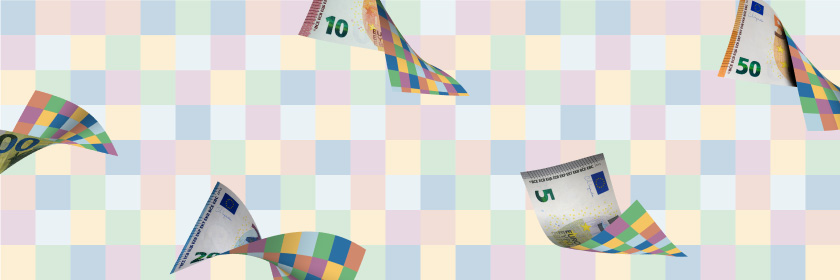The first euro banknotes were introduced on 1 January 2002. Now, more than 20 years later, we are preparing for a future banknote series. The decision on when to launch the new series will be made at a later stage.
The redesign process
In December 2021 the Eurosystem announced its plans to redesign euro banknotes, which are part of the process for developing new ones. We want to ensure banknotes remain available and accessible and continue to be a secure and efficient means of payment.
We also want the banknotes to be as sustainable and environmentally friendly as possible. This is why we are looking at their environmental footprint to identify opportunities to reduce their environmental impact via new products and processes. The process is also an opportunity to make banknotes more inclusive for all Europeans.
The Governing Council of the European Central Bank (ECB) selected "European culture" and "Rivers and birds" as the possible themes to choose from for future euro banknotes. The decision takes into account the results of surveys conducted in the summer of 2023, published in a report today, for the European public to express their preferences from seven shortlisted themes.
In the survey commissioned by the ECB, "European culture" was most popular (21%) amongst euro area citizens, followed by "Rivers: the waters of life in Europe" (18%) and "Birds: free, resilient, inspiring" (17%). The survey comprised a representative sample of 23,377 Europeans.
The next major milestone in the process is to implement the design phase including the selection of possible motifs and a design contest.
We will continue to involve Europeans and relevant experts. Our aim is to ensure the theme and designs selected are relatable for all Europeans.
Main steps in the redesign process

Listening to Europeans
Between December 2021 and March 2022 we asked people in all the euro area countries plus Bulgaria to tell us their opinions on possible themes for future euro banknotes.
Take a look at what was said in the qualitative study on new themes for euro banknotes.
Consulting the experts
End 2021 we established the Theme Advisory Group, an independent, multidisciplinary, and diverse group of experts from all over the euro area, to give advice on possible new themes for future banknotes. Based on the input collected in the qualitative study, the group proposed a shortlist of themes. The ECB’s Governing Council then carefully considered whether the shortlisted themes are relatable to Europeans and represent European life and values, and decided to add a seventh theme, "European culture".
"Birds: free, resilient, inspiring" is inspired by one of the earliest pieces of EU legislation on the environment – the "EU Birds Directive" – that protects all 500 of the area’s wild bird species.
"European Culture" is a rich and diverse mosaic of cultural and creative expression, an inheritance from previous generations of Europeans and a legacy for those to come. European culture contributes to the cohesion and welfare of our societies.
"European values mirrored in nature" represents the six values of the European Union (EU) as defined in the Treaty of Lisbon: human dignity, freedom, democracy, equality, the rule of law, and human rights. The theme also depicts our connection with and respect for nature and the environment.
"The future is yours" focuses on Europeans and their potential to shape the future of Europe with their ideas and vision. It celebrates each and every European, and their skills and visions, in fields ranging from science and technology to art.
"Hands: together we build Europe" is inspired by the EU motto: "United in diversity" and represents all the people who have created Europe. It will represent the six values of the EU: human dignity, freedom, democracy, equality, the rule of law, and human rights, expressed through images of hands.
"Our Europe, our selves" celebrates the individual and collective lives of the people in Europe based on six actions: being, doing, thinking, loving, communicating and living.
"Rivers: the waters of life in Europe" is inspired by European landscapes and combines the natural wonders of Europe with the broader themes of interconnectedness and sustainability.
In summer 2023 we conducteda public survey to ask Europeans of all ages and backgrounds to express their opinions on the shortlisted themes.
What’s next?
The ECB is expected to decide on the final designs, and when to produce and issue the new banknotes, in 2026. Once a decision to produce new banknotes has been taken, it will still be several years before the first banknotes are issued.
